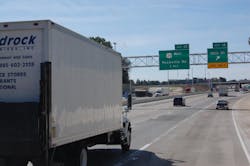The demand for free shipping, especially for e-commerce goods, seems to be placing greater and greater stress on last-mile delivery networks.
That was one of the major findings from the 27th annual State of Logistics report, released last month: that “gaps” in infrastructure and “accelerating trends for speed” are increasingly putting pressure on a logistics system not designed for e-commerce driven “last mile, last minute” delivery service.
“Consumer expectations are changing. They want their products delivered fast and they don’t want to pay a lot of money for delivery,” noted Marc Althen, president of Penske Logistics, in the report. “Shippers are struggling to meet the challenges these expectations create.”
[You can read more about that report’s findings by clicking here and here.]
Yet a singular question remains: can trucking companies actually benefit from this “free shipping” mindset taking hold especially among e-commerce consumers?
Richard “Dick” Metzler, chief marketing officer for uShip Inc., argued in a recent conference call hosted by research firm Stifel Financial Corp., that trucking and logistics companies with “significant network density and/or high revenue per stop” should survive and prosper in a “rapidly evolving transportation” environment focused on more last-mile, “brown glove,” and same-day shipments – goods often touted to consumers as being shipped for free.
Those trends may help foster more partnerships between LTL carriers and regional delivery companies, especially for last-mile “brown glove” shipments, he said.
“Consumer opinions regarding what they desire in a last mile delivery service keep evolving,” he noted. “Each year, more and more consumers list ‘free shipping’ as the number one desired attribute of a last mile delivery program.
For example, a recent survey by United Parcel Service found that free shipping continues to be the most important factor (73%) driving customer satisfaction when checking out online, with the number of shoppers desiring “same-day” shipping for items purchased online continuing to grow at a rapid clip, particularly amongst those that are frequent online shoppers.
Stifel’s research indicates that, among those who shop on-line two times per week or more, same-day delivery is desired by 63%.
“Had not Amazon offered same-day, and in many cases, same-hour delivery services, consumers wouldn’t know they needed them,” uShip’s Metzler pointed out. “Some customers are so desirous of instant or near instant-gratification that they are willing to pay a modest premium for same-day/same-hour delivery.”
Still, he stressed that the “vast number” of customers in search of free shipping are willing to see their ordered items delivered within two to five days, with 43% of Amazon Prime members expecting delivery in two to three days.Yet where Metzler believes opportunity in this “last mile” world exists for trucking firms – especially regional carriers – is so-called “no frills delivery of non-conveyorizable freight” to a home or office; a phrase he boils down to “brown glove service.”
Of late, LTL carriers have largely been handling much of this “brown glove” service, Metzler said, but are finding that they are just not well-equipped to make such “one-off” last mile deliveries of often bulky goods.
That’s where Metzler thinks there may be an “expanding role” for regional delivery companies in the “brown glove” side of the last-mile market: carriers that have been largely displaced out of the document-delivery market by the advent of electronically-transmitted documents. “With some incremental retraining, some systems tweaks, and a slight upsizing of rolling stock, partnerships between carriers and regional delivery companies could evolve into the more optimal solution for providing last mile brown glove delivery solutions,” he said.
Take it a step further: what about regional TL carriers that already have that “upsized” rolling stock? Maybe they could fill that gap as well. Although, Metzler didn’t speculate on that aspect such “brown glove” partnerships, it’s sure to be running through more than a few minds out there.
Could that in turn boost the potential profitability of “last mile” shipments? That remains to be seen, But it’s worth contemplating simply as more and more freight – especially in from e-commerce markets – seems to be heading in that direction.





